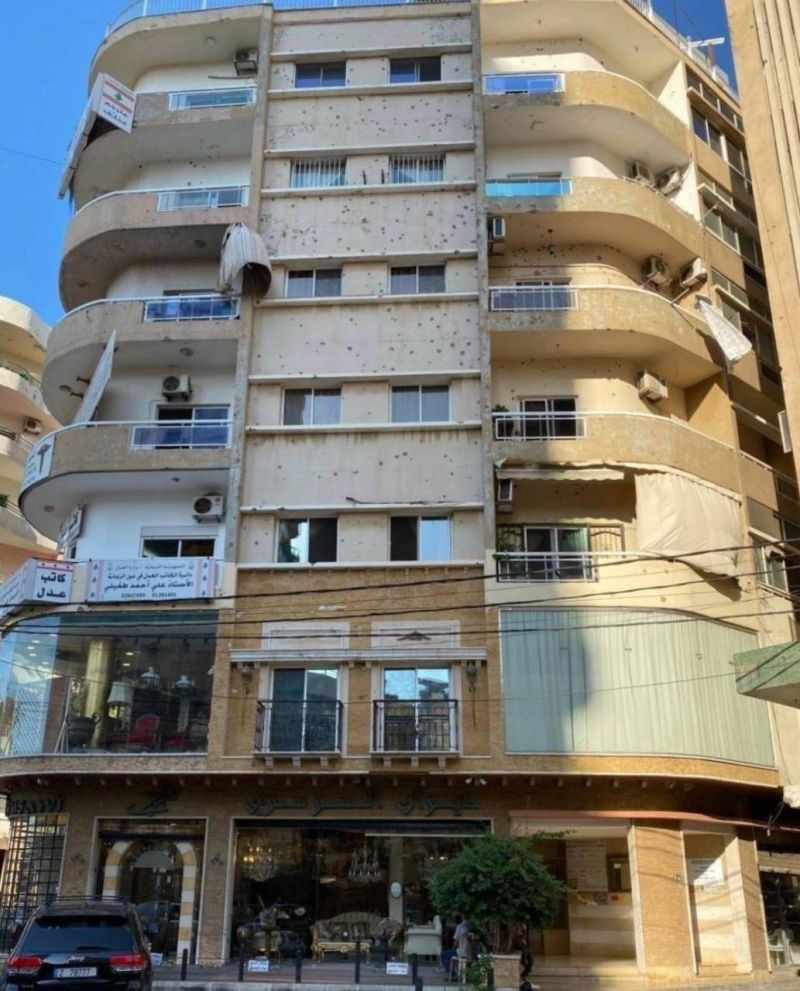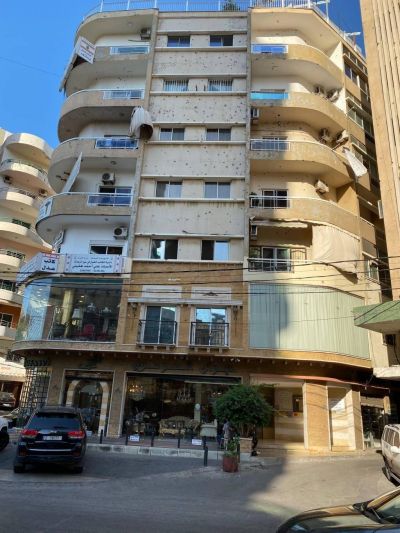
A year after the Oct. 14, 2021 Tayyouneh clashes in southern Beirut, a building is still riddled with bullets. (Credit: Anne-Marie El Hage/L'Orient-Le Jour)
BEIRUT — The horns of impatient motorists blare in the October heat.
Employees emerge from their offices after the day's work. In a local cafe, men kill time smoking hookahs. Busy women do their final shopping. Desperately empty, clothing stores display sale signs. It’s a normal, early autumn day in the neighboring districts of Chiyah and Ain al-Rummaneh just south of Beirut.
One of the neighborhoods is predominantly Shiite, the other predominantly Christian, separated by the Old Saida Road, which served as a dividing line during the Civil War (1975-1990). Only the facades of buildings, riddled with bullets, attest to the violent exchanges that left seven people dead and dozens wounded on Oct. 14, 2021.
On that day, fighters with the Amal-Hezbollah alliance exchanged fire with Christian fighters, presumed to be close to the Lebanese Forces, on the sidelines of a protest at the Palace of Justice against Judge Tarek Bitar, lead investigator of the Aug. 4, 2020, Beirut port explosion probe.
Residents concerned about purchasing power
One year later, life has returned to normal. And if the stories sometimes differ from one neighborhood to another, the main worry of residents now is their purchasing power. All this is in the context of an acute economic crisis and record collapse of the national currency, which recently approached LL40,000 to the dollar.
Whether in Chiyah or Ain al-Rummaneh, residents who spoke with L’Orient-Le Jour say they are now more concerned about the price of bread or shisha than the clashes of a year ago.
"It is an incident like any other that has marred our daily life since the Civil War. What has changed, however, is the price of shisha, which has risen from LL10,000 to LL70,000," grumbles Andre, sitting at a cafe in Tayyouneh.
Nearby, a few meters from Laure Moghaizel street where the violence began, a hurried resident blames the ruling class.
"They stole our money blocked in the banks. We can't even live decently anymore," said one woman, who declined to be named. “That day, despite the rocket fire that rang out nearby, I didn't stop painting. I just wanted it to stop, because I had to finish a painting.”
Living together a priority
In the course of these conversations, each resident expressed their desire to coexist with the others.
"That day, all it took was a snap of the community leaders' fingers for the militia to invade the streets and for people to be killed,” said Hassan Dia, whose clothing store on the Chiyah side suffered damages he estimated to be around $40,000. “It was a crazy move! And we, the normal citizens who live in peace and harmony with our compatriots, are paying the price."
"There is no before-and-after for the clashes. There is just a serious economic crisis that affects more than 90 percent of the population and reduced our business to zero," Dia added.
On the opposite side of the street, Mohammad Moussaoui lamented the "$180,000 in damages” to his antique store. According to him, the whole storefront was broken and 43 Persian rugs were damaged.
Despite the trauma his family experienced that day — some took refuge in the basement while others fled from the balcony — the antique dealer decided to refurbish the shop.
"The neighborhood is back to being as beautiful as it was before, and I still have hope," Moussaoui said. "I am a Shiite, not a partisan. I have friends in the Christian areas, in Chiyah and Ain al-Rummaneh. And I will continue."
Residents in the Christian neighborhood echoed Moussaoui’s sentiments.
"I saw the partisans of both sides under my window. I heard the provocations, the insults, and [felt] the tension rising,” recalls Marc Ata, a law student, who said he watched the clashes “in terror."
For many, that fear is still there.
In Ain al-Rummaneh and neighboring Furn al-Shubbak, a large part of the population lived through the Civil War and fear a repetition of history.
"A year ago, I was at my job on Sami al-Solh Boulevard,” said Fady, a resident of Ain al-Rummaneh. When pro-Amal and pro-Hezbollah protesters reportedly entered the neighborhood that day last year, “I hid in the building's storage room and didn’t come out until hours later.”
Fady denounced "the proliferation of weapons" and said he is "terrified” of seeing armed fighters invade his neighborhood.
"Things are not like they used to be," added shopkeeper Souheil Sinno, who has since moved to the mountains outside the city. He hopes "such incidents will never happen again.”
This article was originally published in French in L'Orient-Le Jour.

